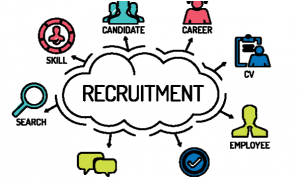Develop and Track goals for the recruiting and hiring process.
1.Selection and Recruitment.
HR’s primary function is recruitment and selection. It entails determining the need for a position, writing job descriptions, defining the role’s requirements and the ideal candidate’s skill set, establishing pay budgets, advertising to the appropriate people, screening, interviewing, and selecting the best candidate for the job. Although it may appear simple, this service is more than just locating people to fill positions. Placing the ideal individuals in the proper positions can have a significant impact on employee retention and generate a happier workforce if done correctly, by clearly defining job standards and specifying the employee profile.
“On boarding,” also known as “organisation socialisation” is a common part of the recruitment process that is usually supported and monitored by HR employees.

2.Education and Development.
Human Resources Employee skill or training deficiencies must be addressed, and employees must be given the resources they need to strengthen their skill sets, improve their confidence, and perform more successfully. Employee happiness and morale improve significantly when employers engage in their staff in this way. They are perceived as respected and supported, and they are more likely to be engaged in their work.
A corporation might also profit from personnel training. Investing in the development of employees improves employee retention and reduces recruitment costs. It also makes your organisation more appealing to potential recruits looking to advance their careers by expanding their opportunities.
Training is also necessary for industry developments and innovation, as well as for staff retention.
3.Performance Management.
Human Resources, with the support of line managers, frequently facilitates performance management. It is a tool for tracking progress and evaluating the work, attitude, efficiency, and effectiveness of staff.
Quarterly or annual performance assessments or reviews are an important part of an effective performance management strategy. These promote one-on-one communication between employees and line managers, allowing them to create clear individual and team goals that are aligned with the organization’s strategic goals.
A performance management cycle is made up of a number of interconnected actions that make up the process of performance management. Setting SMART (specific, measurable, attainable, relevant, and time-bound) objectives and a Personal Development Plan to achieve those goals, reviewing and assessing the success of these plans, and developing the Personal Development Plan are all part of this process.
4.Relationships with coworkers.
When it comes to employee relations, there are two basic functions (ER). To begin with, HR aids in the prevention and resolution of difficulties or conflicts between employees and management. Second, they aid in the creation and enforcement of policies that are fair and consistent across the board.
Employee happiness rises as a result of good interactions. Employee relations refers to an organization’s efforts to establish and maintain healthy working relationships between employees and their bosses. ER is critical for organisational success, employee loyalty, and increased engagement. It has to do with line managers and their team members, both individually and collectively. It also encompasses contractual and practical partnerships, as well as the personal and emotional aspects of those relationships.
HR personnel are usually in charge of ER, which entails their acting as a liaison or intermediate between employees and managers. They help develop and implement policies for issues like as fair salary, suitable working hours, work-life balance, and relevant benefits for employees. Employee relations also includes whistleblowing and disciplinary procedures.
5.Employment Law and Regulations.
Every HR professional should be familiar with and up to date on employment law in order to guarantee that the company’s policies, procedures, and benefits are compliant with the most recent regulations. The legal framework under which the company must function is known as employment law. There are numerous rules and regulations that govern various aspects of human resource management, including recruitment, performance management, employee relations, compensation, and health and safety.
Despite being one of HR’s most complex and important tasks, strict adherence to applicable employment regulations can assist avoid legal issues. Employers and their employees may assist eliminate prejudice and promote equality in the workplace by ensuring that their processes are fair to all parties involved.
6.Remuneration and Perks.
Every employee’s favourite HR function is probably compensation and benefits. Compensation refers to the base compensation that each employee has agreed to. Employee benefits can include pay raises tied to appraisals, social security, pensions, private health insurance, longevity perks, corporate discounts, paid holidays, paid sick leave, childcare facilities, profit sharing, gym membership, and many other things, depending on the company’s and employees’ priorities.
Tag:#HR, #HRServices, #Recruitment
